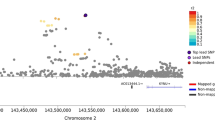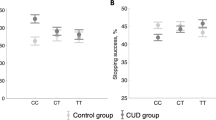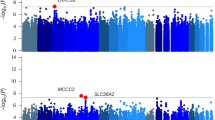Abstract
We recently reported that, in a European-American (EA) sample, the interaction between two cannabinoid receptor 1 gene (CNR1) variants significantly increased risk for drug dependence (DD), including cocaine dependence (CD). This study aimed to investigate directly the association between CNR1 and CD in four independent samples. Eight markers across the 45 kb CNR1 region and four large samples, ie, family-based European-American (EA) sample (n=734), case–control EA sample (n=862), family-based African-American (AA) sample (n=834) and case–control AA sample (n=619) were examined in the present study. We investigated the association of these markers with CD and cocaine-induced paranoia (CIP) in the EA family sample first, and then replicated positive results in the other three samples. The interaction between two independent CNR1 variants, ie, the G allele-containing genotypes of rs6454674 (SNP3∧G+), and the T/T genotype of rs806368 (SNP8∧T/T), significantly increased risk for CD in the EA family (PGEE=0.015) and EA case–control (Pregression=0.003) samples. EA subjects with SNP3∧G+ and SNP8∧T/T had higher risk to develop CD than those EA subjects with the other genotypes for these two SNPs (LR+=1.4). The SNP3∧G-SNP8∧T haplotype also showed significant association (P=0.018) with CD in the EA case–control sample. SNP8-containing haplotypes showed significant association with both CD (Pglobal=0.007) and CIP (Pglobal=0.003) in the EA family sample. In the AA family sample, SNP8∧T/T significantly conferred higher risk for CD (P=0.019). We conclude that two independent CNR1 variants have significant interaction effects on risk for CD in EAs; they may also have effects on risk for CD in AAs.
Similar content being viewed by others
Log in or create a free account to read this content
Gain free access to this article, as well as selected content from this journal and more on nature.com
or
References
American Psychiatric Association (1987). Diagnostic and Statistical Manual of Mental Disorders, 3rd edn., revised. American Psychiatric Press: Washington, DC.
American Psychiatric Association (1994). Diagnostic and Statistical Manual of Mental Disorders, 4th edn. American Psychiatric Press: Washington, DC.
Andersen MC, Engstrom PG, Lithwick S, Arenillas D, Eriksson P, Lenhard B et al (2008). In silico detection of sequence variations modifying transcriptional regulation. PLoS Comput Biol 4: e5.
Arnold JC (2005). The role of endocannabinoid transmission in cocaine addiction. Pharmacol Biochem Behav 81: 396–406.
Ballon N, Leroy S, Roy C, Bourdel MC, Charles-Nicolas A, Krebs MO et al (2006). (AAT)n repeat in the cannabinoid receptor gene (CNR1): association with cocaine addiction in an African-Caribbean population. Pharmacogenomics J 6: 126–130.
Barrett JC, Fry B, Maller J, Daly MJ (2005). Haploview: analysis and visualization of LD and haplotype maps. Bioinformatics 21: 263–265.
Benn-Torres J, Bonilla C, Robbins CM, Waterman L, Moses TY, Hernandez W et al (2008). Admixture and population stratification in African Caribbean populations. Ann Hum Genet 72: 90–98.
Caille S, Alvarez-Jaimes L, Polis I, Stouffer DG, Parsons LH (2007). Specific alterations of extracellular endocannabinoid levels in the nucleus accumbens by ethanol, heroin, and cocaine self-administration. J Neurosci 27: 3695–3702.
Carlson G, Wang Y, Alger BE (2002). Endocannabinoids facilitate the induction of LTP in the hippocampus. Nat Neurosci 5: 723–724.
Centonze D, Battista N, Rossi S, Mercuri NB, Finazzi-Agro A, Bernardi G et al (2004). A critical interaction between dopamine D2 receptors and endocannabinoids mediates the effects of cocaine on striatal gabaergic Transmission. Neuropsychopharmacology 29: 1488–1497.
Cheer JF, Wassum KM, Sombers LA, Heien ML, Ariansen JL, Aragona BJ et al (2007). Phasic dopamine release evoked by abused substances requires cannabinoid receptor activation. J Neurosci 27: 791–795.
Chen WM, Broman KW, Liang KY (2004). Quantitative trait linkage analysis by generalized estimating equations: unification of variance components and Haseman-Elston regression. Genet Epidemiol 26: 265–272.
Chevaleyre V, Takahashi KA, Castillo PE (2006). Endocannabinoid-mediated synaptic plasticity in the CNS. Annu Rev Neurosci 29: 37–76.
Comings DE, Muhleman D, Gade R, Johnson P, Verde R, Saucier G et al (1997). Cannabinoid receptor gene (CNR1): association with i.v. drug use. Mol Psychiatry 2: 161–168.
Cossu G, Ledent C, Fattore L, Imperato A, Bohme GA, Parmentier M et al (2001). Cannabinoid CB1 receptor knockout mice fail to self-administer morphine but not other drugs of abuse. Behav Brain Res 118: 61–65.
Covault J, Gelernter J, Kranzler H (2001). Association study of cannabinoid receptor gene (CNR1) alleles and drug dependence. Mol Psychiatry 6: 501–502.
Cubells JF, Kranzler HR, McCance-Katz E, Anderson GM, Malison RT, Price LH et al (2000). A haplotype at the DBH locus, associated with low plasma dopamine beta-hydroxylase activity, also associates with cocaine-induced paranoia. Mol Psychiatry 5: 56–63.
De Vries TJ, Shaham Y, Homberg JR, Crombag H, Schuurman K, Dieben J et al (2001). A cannabinoid mechanism in relapse to cocaine seeking. Nat Med 7: 1151–1154.
Di Chiara G, Imperato A (1988). Drugs abused by humans preferentially increase synaptic dopamine concentrations in the mesolimbic system of freely moving rats. Proc Natl Acad Sci USA 85: 5274–5278.
Di Marzo V, Bifulco M, De Petrocellis L (2004). The endocannabinoid system and its therapeutic exploitation. Nat Rev 3: 771–784.
Gelernter J, Kranzler HR, Satel SL, Rao PA (1994). Genetic association between dopamine transporter protein alleles and cocaine-induced paranoia. Neuropsychopharmacology 11: 195–200.
Gelernter J, Panhuysen C, Weiss R, Brady K, Hesselbrock V, Rounsaville B et al (2005). Genomewide linkage scan for cocaine dependence and related traits: significant linkages for a cocaine-related trait and cocaine-induced paranoia. Am J Med Genet B Neuropsychiatr Genet 136B: 45–52.
Giuffrida A, Parsons LH, Kerr TM, Rodriguez de Fonseca F, Navarro M, Piomelli D (1999). Dopamine activation of endogenous cannabinoid signaling in dorsal striatum. Nature neuroscience 2: 358–363.
Hanley JA, Negassa A, Edwardes MD, Forrester JE (2003). Statistical analysis of correlated data using generalized estimating equations: an orientation. Am J Epidemiol 157: 364–375.
Heller D, Schneider U, Seifert J, Cimander KF, Stuhrmann M (2001). The cannabinoid receptor gene (CNR1) is not affected in German i.v. drug users. Addict Biol 6: 183–187.
Herkenham M, Lynn AB, Little MD, Johnson MR, Melvin LS, de Costa BR et al (1990). Cannabinoid receptor localization in brain. Proc Natl Acad Sci USA 87: 1932–1936.
Herman AI, Kranzler HR, Cubells JF, Gelernter J, Covault J (2006). Association study of the CNR1 gene exon 3 alternative promoter region polymorphisms and substance dependence. Am J Med Genet B Neuropsychiatr Genet 141B: 499–503.
Hopfer CJ, Young SE, Purcell S, Crowley TJ, Stallings MC, Corley RP et al (2006). Cannabis receptor haplotype associated with fewer cannabis dependence symptoms in adolescents. Am J Med Genet B Neuropsychiatr Genet 141B: 895–901.
Hutchison KE, Haughey H, Niculescu M, Schacht J, Kaiser A, Stitzel J et al (2008). The incentive salience of alcohol: translating the effects of genetic variant in CNR1. Arch Gen Psychiatry 65: 841–850.
Hyman SE, Malenka RC, Nestler EJ (2006). Neural mechanisms of addiction: the role of reward-related learning and memory. Annu Rev Neurosci 29: 565–598.
Kalayasiri R, Sughondhabirom A, Gueorguieva R, Coric V, Lynch WJ, Lappalainen J et al (2007). Dopamine beta-hydroxylase gene (DbetaH) -1021C-->T influences self-reported paranoia during cocaine self-administration. Biol Psychiatry 61: 1310–1313.
Koob GF (1992). Drugs of abuse: anatomy, pharmacology and function of reward pathways. Trends Pharmacol Sci 13: 177–184.
Koob GF, Le Moal M (2001). Drug addiction, dysregulation of reward, and allostasis. Neuropsychopharmacology 24: 97–129.
Koob GF, Le Moal M (2008). Addiction and the brain antireward system. Annu Rev Psychol 59: 29–53.
Kranzler HR, Wilcox M, Weiss RD, Brady K, Hesselbrock V, Rounsaville B et al (2008). The validity of cocaine dependence subtypes. Addict Behav 33: 41–53.
Laird NM, Horvath S, Xu X (2000). Implementing a unified approach to family-based tests of association. Genet Epidemiol 19 (Suppl 1): S36–S42.
Lange C, Silverman EK, Xu X, Weiss ST, Laird NM (2003). A multivariate family-based association test using generalized estimating equations: FBAT-GEE. Biostatistics 4: 195–206.
Li T, Liu X, Zhu ZH, Zhao J, Hu X, Ball DM et al (2000). No association between (AAT)n repeats in the cannabinoid receptor gene (CNR1) and heroin abuse in a Chinese population. Mol Psychiatry 5: 128–130.
Liang K, Zeger S (1986). Longitudinal data analysis using generalized linear models. Biometrika 73: 13–22.
Liu K, Muse SV (2005). PowerMarker: an integrated analysis environment for genetic marker analysis. Bioinformatics 21: 2128–2129.
Lonjou C, Zhang W, Collins A, Tapper WJ, Elahi E, Maniatis N et al (2003). Linkage disequilibrium in human populations. Proceedings of the National Academy of Sciences of the United States of America 100: 6069–6074.
Luo X, Kranzler HR, Zuo L, Lappalainen J, Yang BZ, Gelernter J (2006). ADH4 gene variation is associated with alcohol dependence and drug dependence in European Americans: results from HWD tests and case–control association studies. Neuropsychopharmacology 31: 1085–1095.
Lupica CR, Riegel AC (2005). Endocannabinoid release from midbrain dopamine neurons: a potential substrate for cannabinoid receptor antagonist treatment of addiction. Neuropharmacology 48: 1105–1116.
Mailleux P, Vanderhaeghen JJ (1992). Distribution of neuronal cannabinoid receptor in the adult rat brain: a comparative receptor binding radioautography and in situ hybridization histochemistry. Neuroscience 48: 655–668.
Miller NS, Klahr AL, Gold MS, Sweeney K, Cocores JA (1990). The prevalence of marijuana (cannabis) use and dependence in cocaine dependence. N Y State J Med 90: 491–492.
Nestler EJ (2005). Is there a common molecular pathway for addiction? Nat Neurosci 8: 1445–1449.
O’Connell JR, Weeks DE (1998). PedCheck: a program for identification of genotype incompatibilities in linkage analysis. Am J Hum Genet 63: 259–266.
Pan B, Hillard CJ, Liu QS (2008). Endocannabinoid signaling mediates cocaine-induced inhibitory synaptic plasticity in midbrain dopamine neurons. J Neurosci 28: 1385–1397.
Ponce G, Hoenicka J, Rubio G, Ampuero I, Jimenez-Arriero MA, Rodriguez-Jimenez R et al (2003). Association between cannabinoid receptor gene (CNR1) and childhood attention deficit/hyperactivity disorder in Spanish male alcoholic patients. Mol Psychiatry 8: 466–467.
Pritchard JK, Stephens M, Donnelly P (2000a). Inference of population structure using multilocus genotype data. Genetics 155: 945–959.
Pritchard JK, Stephens M, Rosenberg NA, Donnelly P (2000b). Association mapping in structured populations. Am J Hum Genet 67: 170–181.
Schmidt LG, Samochowiec J, Finckh U, Fiszer-Piosik E, Horodnicki J, Wendel B et al (2002). Association of a CB1 cannabinoid receptor gene (CNR1) polymorphism with severe alcohol dependence. Drug Alcohol Depend 65: 221–224.
Shi MM, Myrand SP, Bleavins MR, de la Iglesia FA (1999). High throughput genotyping for the detection of a single nucleotide polymorphism in NAD(P)H quinone oxidoreductase (DT diaphorase) using TaqMan probes. Mol Pathol 52: 295–299.
Solinas M, Goldberg SR, Piomelli D (2008). The endocannabinoid system in brain reward processes. Br J Pharmacol 154: 369–383.
Soria G, Mendizabal V, Tourino C, Robledo P, Ledent C, Parmentier M et al (2005). Lack of CB1 cannabinoid receptor impairs cocaine self-administration. Neuropsychopharmacology 30: 1670–1680.
Spielman RS, McGinnis RE, Ewens WJ (1993). Transmission test for linkage disequilibrium: the insulin gene region and insulin-dependent diabetes mellitus (IDDM). Am J Hum Genet 52: 506–516.
Spitzer R, Endicott J (1975). Schedule for Affective Disorders and Schizophrenia: Lifetime Version. New York Biometrics Research Division, New York State Psychiatric Institute: New York.
Tanda G, Goldberg SR (2003). Cannabinoids: reward, dependence, and underlying neurochemical mechanisms—a review of recent preclinical data. Psychopharmacology 169: 115–134.
Tsou K, Brown S, Sanudo-Pena MC, Mackie K, Walker JM (1998). Immunohistochemical distribution of cannabinoid CB1 receptors in the rat central nervous system. Neuroscience 83: 393–411.
Wedderburn R (1974). Quasi-likelihood functions, generalized linear models, and the Gauss–Newton method. Biometrika 61: 439–447.
Yang BZ, Zhao H, Kranzler HR, Gelernter J (2005). Practical population group assignment with selected informative markers: characteristics and properties of Bayesian clustering via STRUCTURE. Genet Epidemiol 28: 302–312.
Yu Y, Kranzler HR, Panhuysen C, Weiss RD, Poling J, Farrer LA et al (2008). Substance dependence low-density whole genome association study in two distinct American populations. Hum Genet 123: 495–506.
Zeger SL, Liang KY (1986). Longitudinal data analysis for discrete and continuous outcomes. Biometrics 42: 121–130.
Zhang PW, Ishiguro H, Ohtsuki T, Hess J, Carillo F, Walther D et al (2004). Human cannabinoid receptor 1: 5′ exons, candidate regulatory regions, polymorphisms, haplotypes and association with polysubstance abuse. Mol Psychiatry 9: 916–931.
Zuo L, Kranzler HR, Luo X, Covault J, Gelernter J (2007). CNR1 variation modulates risk for drug and alcohol dependence. Biol Psychiatry 62: 616–626.
Acknowledgements
Ann Marie Lacobelle and Greg Kay provided excellent technical assistance. This work was supported in part by National Institute on Drug Abuse (NIDA) grants R01-DA12849, R01-DA12690, K24-DA15105, NIAAAR01- AA11330 (J. Gelernter), and K24-DA022288 (R, Weiss); National Institute on Alcohol Abuse and Alcoholism (NIAAA) grants R01-AA016015, P50-AA12870, P50-AA03510, and K24-AA13736 (H. Kranzler); National Center for Research Resources (NCRR) grant M01-RR06192; and by Alcoholic Beverage Medical Research Foundation (ABMRF) grant award R06932 (X. Luo); U.S. Department of Veterans Affairs (the VA Medical Research Program, VA Alcohol Research Center, and the VA Connecticut–Massachusetts Mental Illness Research, Education and Clinical Center (MIRECC); and the VA Research Enhancement Award Program (REAP) research center).
Author information
Authors and Affiliations
Corresponding author
Additional information
DISCLOSURE/CONFLICT OF INTEREST
Dr Kranzler has received financial support or compensation for the following: related to consultation on grant reviews for the National Institutes of Health and related to academic lectures and editorial functions in various scientific venues; and has been a paid consultant to Alkermes Inc., Ortho-McNeil Pharmaceuticals, Thomson Healthcare, Sanofi-Aventis, Lundbeck, Forest Pharmaceuticals, Elbion NV, Bristol-Myers Squibb Co., and Solvay Pharmaceuticals. He has received research support from Ortho-McNeil Pharmaceuticals and Bristol-Myers Squibb Co. Dr Weiss has received financial support or compensation for the following: related to consultation on grant reviews for the National Institutes of Health and related to academic lectures and editorial functions in various scientific venues; and has been a paid consultant to Eli Lilly Co., Novartis Pharmaceuticals, Titan Pharmaceuticals and AstraZeneca Pharmaceuticals. Dr Gelernter has received financial support or compensation for the following: related to consultation for Columbia University, the Thailand Center for Excellence for Life Sciences (TCELS), the University of CT Health Center, NIH, related to grant reviews for the National Institutes of Health; and related to academic lectures and editorial functions in various scientific venues (including from ACNP). The other authors declare that they have not received any compensation for research or professional service that could be perceived as constituting a potential conflict of interest.
Rights and permissions
About this article
Cite this article
Zuo, L., Kranzler, H., Luo, X. et al. Interaction between Two Independent CNR1 Variants Increases Risk for Cocaine Dependence in European Americans: A Replication Study in Family-Based Sample and Population-Based Sample. Neuropsychopharmacol 34, 1504–1513 (2009). https://doi.org/10.1038/npp.2008.206
Received:
Revised:
Accepted:
Published:
Issue date:
DOI: https://doi.org/10.1038/npp.2008.206
Keywords
This article is cited by
-
Role of mesolimbic cannabinoid receptor 1 in stress-driven increases in cocaine self-administration in male rats
Neuropsychopharmacology (2023)
-
Genotype-by-diagnosis interaction influences self-control in human cocaine addiction
Translational Psychiatry (2023)
-
Cannabinoid type 1 receptors in A2a neurons contribute to cocaine-environment association
Psychopharmacology (2021)
-
Cannabinoid receptor CNR1 expression and DNA methylation in human prefrontal cortex, hippocampus and caudate in brain development and schizophrenia
Translational Psychiatry (2020)
-
Environmental, genetic and epigenetic contributions to cocaine addiction
Neuropsychopharmacology (2018)



